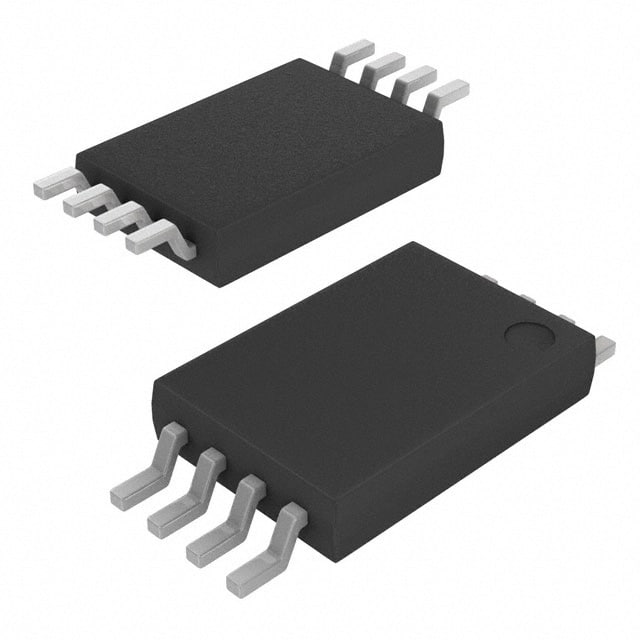AT24C128-10TU-2.7-T
Product Overview
Category
AT24C128-10TU-2.7-T belongs to the category of EEPROM (Electrically Erasable Programmable Read-Only Memory) chips.
Use
This product is commonly used for non-volatile data storage in various electronic devices such as microcontrollers, computers, and consumer electronics.
Characteristics
- Non-volatile memory: The AT24C128-10TU-2.7-T retains stored data even when power is removed.
- High storage capacity: It has a capacity of 128 kilobits (16 kilobytes).
- Low power consumption: The chip operates at a low voltage of 2.7V and consumes minimal power during read and write operations.
- I2C interface: It utilizes the I2C (Inter-Integrated Circuit) protocol for communication with other devices.
- Small package size: The chip is available in a compact Thin Small Outline Package (TSOP).
Packaging/Quantity
The AT24C128-10TU-2.7-T is typically packaged in reels or tubes, containing a specific quantity of chips per package. The exact packaging and quantity may vary depending on the manufacturer and supplier.
Specifications
- Capacity: 128 kilobits (16 kilobytes)
- Operating Voltage: 2.7V
- Interface: I2C
- Package Type: Thin Small Outline Package (TSOP)
- Temperature Range: -40°C to +85°C
- Write Cycle Endurance: 1 million cycles
- Data Retention: 100 years
Detailed Pin Configuration
The AT24C128-10TU-2.7-T chip has a total of 8 pins, which are assigned specific functions:
- A0: Address Input
- A1: Address Input
- A2: Address Input
- GND: Ground
- SDA: Serial Data Input/Output
- SCL: Serial Clock Input
- WP: Write Protect
- VCC: Power Supply
Functional Features
- Random access: The chip allows random read and write operations to specific memory locations.
- Byte-level operations: It supports byte-level read and write operations, enabling efficient data manipulation.
- Hardware write protection: The WP pin can be used to protect the stored data from accidental modification.
- Sequential read mode: It offers a sequential read mode for faster data retrieval.
Advantages and Disadvantages
Advantages
- Non-volatile storage ensures data retention even during power loss.
- High storage capacity suitable for various applications.
- Low power consumption extends battery life in portable devices.
- Compact package size enables integration into space-constrained designs.
- I2C interface simplifies communication with other devices.
Disadvantages
- Limited write cycle endurance may restrict certain high-frequency data update applications.
- Relatively slower write speed compared to other memory technologies.
- Vulnerable to electromagnetic interference due to its non-shielded package design.
Working Principles
The AT24C128-10TU-2.7-T utilizes EEPROM technology, which allows electrical modification of stored data. It consists of an array of memory cells that can be individually addressed for read or write operations. The I2C interface facilitates communication between the chip and the controlling device, enabling seamless data transfer.
Detailed Application Field Plans
The AT24C128-10TU-2.7-T finds application in various fields, including but not limited to: - Embedded systems - Industrial automation - Automotive electronics - Smart home devices - Medical equipment - Consumer electronics
Detailed and Complete Alternative Models
- AT24C01A: 1 kilobit (128 bytes) capacity, I2C interface.
- AT24C256C: 256 kilobits (32 kilobytes) capacity, I2C interface, extended temperature range.
- AT24CM02: 2 megabits (256 kilobytes) capacity, I2C interface, low voltage operation.
These alternative models offer different capacities and additional features to cater to specific application requirements.
Word count: 526 words
Senaraikan 10 soalan dan jawapan biasa yang berkaitan dengan aplikasi AT24C128-10TU-2.7-T dalam penyelesaian teknikal
Sure! Here are 10 common questions and answers related to the application of AT24C128-10TU-2.7-T in technical solutions:
Q: What is the AT24C128-10TU-2.7-T? A: The AT24C128-10TU-2.7-T is a serial EEPROM (Electrically Erasable Programmable Read-Only Memory) chip with a capacity of 128 kilobits (16 kilobytes).
Q: What are the main features of the AT24C128-10TU-2.7-T? A: The main features include a 2-wire serial interface, low power consumption, 1 million write cycles endurance, and a wide operating voltage range.
Q: How can I interface with the AT24C128-10TU-2.7-T? A: The AT24C128-10TU-2.7-T uses a standard I2C (Inter-Integrated Circuit) interface, which allows for easy integration with microcontrollers and other devices.
Q: What are some typical applications of the AT24C128-10TU-2.7-T? A: The AT24C128-10TU-2.7-T is commonly used in applications such as data logging, configuration storage, security keys, and parameter storage in various electronic systems.
Q: What is the operating voltage range of the AT24C128-10TU-2.7-T? A: The AT24C128-10TU-2.7-T operates within a voltage range of 1.7V to 5.5V, making it compatible with a wide range of systems.
Q: How many write cycles can the AT24C128-10TU-2.7-T endure? A: The AT24C128-10TU-2.7-T can endure up to 1 million write cycles, ensuring reliable and long-lasting data storage.
Q: What is the maximum clock frequency supported by the AT24C128-10TU-2.7-T? A: The AT24C128-10TU-2.7-T supports a maximum clock frequency of 400 kHz, allowing for fast data transfer.
Q: Can I use multiple AT24C128-10TU-2.7-T chips in my system? A: Yes, you can use multiple AT24C128-10TU-2.7-T chips in your system by assigning unique addresses to each chip using the address pins.
Q: Is the AT24C128-10TU-2.7-T compatible with both 3.3V and 5V systems? A: Yes, the AT24C128-10TU-2.7-T is designed to be compatible with both 3.3V and 5V systems, making it versatile for various applications.
Q: Are there any specific precautions I should take when using the AT24C128-10TU-2.7-T? A: It is recommended to follow the datasheet guidelines for proper handling, voltage levels, and timing requirements to ensure optimal performance and reliability of the chip.
Please note that these answers are general and may vary depending on the specific requirements and implementation of the AT24C128-10TU-2.7-T in different technical solutions.


